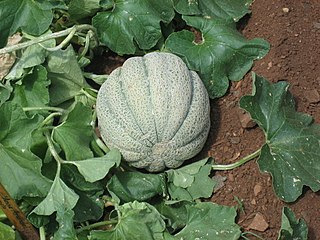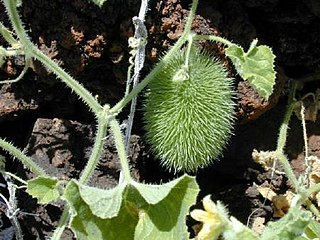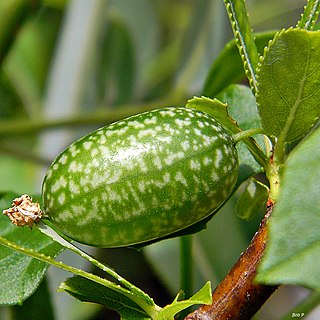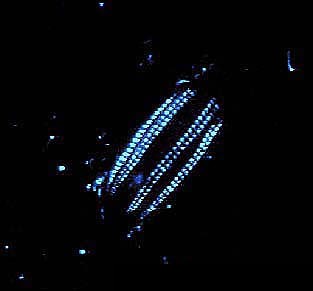
The cucumber is a widely-cultivated creeping vine plant in the family Cucurbitaceae that bears cylindrical to spherical fruits, which are used as culinary vegetables. Considered an annual plant, there are three main types of cucumber—slicing, pickling, and seedless—within which several cultivars have been created. The cucumber originates in Asia extending from India, Nepal, Bangladesh, China, and Northern Thailand, but now grows on most continents, and many different types of cucumber are grown commercially and traded on the global market. In North America, the term wild cucumber refers to plants in the genera Echinocystis and Marah, though the two are not closely related.

A melon is any of various plants of the family Cucurbitaceae with sweet, edible, and fleshy fruit. It can also specifically refer to Cucumis melo, commonly known as the "true melon" or simply "melon". The term "melon" can apply to both the plant and its fruit. Botanically, a melon is a kind of berry, specifically a "pepo". The word melon derives from Latin melopepo, which is the latinization of the Greek μηλοπέπων (mēlopepōn), meaning "melon", itself a compound of μῆλον (mēlon), "apple", treefruit " and πέπων (pepōn), amongst others "a kind of gourd or melon". Many different cultivars have been produced, particularly of the true melon, such as the cantaloupe and honeydew.

Cucumis is a genus of twining, tendril-bearing plants in the family Cucurbitaceae which includes the cucumber, true melons, the horned melon, and the West Indian gherkin.

Cucumis metuliferus commonly called the African horned cucumber, horned melon, spiked melon, jelly melon, or kiwano, is an annual vine in the cucumber and melon family Cucurbitaceae. Its fruit has horn-like spines, hence the name "horned melon". The ripe fruit has orange skin and lime-green, jelly-like flesh. C. metuliferus is native to Southern Africa, in South Africa, Namibia, Botswana, Zambia, Malawi, Zimbabwe, Mozambique, and Angola.

Cucumis anguria, commonly known as maroon cucumber, West Indian gherkin, maxixe, burr gherkin, cackrey, and West Indian gourd, is a vine that is indigenous to Africa, but has become naturalized in the New World, and is cultivated in many places. It is similar and related to the common cucumber (C. sativus) and its cultivars are known as gherkins.

The Armenian cucumber, Cucumis melo Flexuosus Group or Cucumis melo var. flexuosus, is a type of long, slender fruit which tastes like a cucumber and looks somewhat like a cucumber inside. It is actually a variety of true melon, a species closely related to the cucumber. It is also known as the yard-long cucumber, snake cucumber, snake melon, Varunk in Armenian, chanbar in Persian, sheng in Semnani, chirimenhosonagauri in Japanese, acur in Turkish, kakadee in Hindi, tar in Punjabi, قثاء in Arabic, commarella or tortarello in Italian. It should not be confused with the snake gourds. The skin is very thin, light green, and bumpless. It has no bitterness and the fruit is almost always used without peeling. It is also sometimes called a gutah.

The honeydew melon is one of the two main cultivar types in Cucumis melo Inodorus Group. It is characterized by the smooth, often green or yellowish rind and lack of musky odor. The other main type in the Inodorus Group is the wrinkle-rind casaba melon.

Cucumis myriocarpus, the gooseberry cucumber, gooseberry gourd, paddy melon, mallee pear or prickly paddy melon, is a prostrate or climbing annual herb native to tropical and southern Africa. It has small, round, yellow-green or green-striped fruit with soft spines, small yellow flowers and deeply lobed, light green leaves. The melon occurs in disturbed soil and cleared or bare areas, and thrives on summer moisture.

Cucumis melo, also known as melon, is a species of Cucumis that has been developed into many cultivated varieties. The fruit is a pepo. The flesh is either sweet or bland, with or without an aroma, and the rind can be smooth, ribbed, wrinkled, or netted. The species is sometimes referred to as muskmelon, but there is no consensus about the usage of this term, as it can also be used as a specific name for the musky netted-rind American cantaloupe, or as a generic name for any sweet-flesh variety such the inodorous smooth-rind honeydew melon.

Pleurobrachia is a common genus of Ctenophora. Along with the genus Hormiphora, it generally has the common name sea gooseberry. It contains the following species:
Paddy melon is a common name for two species of plants in the melon family which are invasive in Australia:

Beroe cucumis is a species of comb jelly in the family Beroidae. It is found in the Atlantic Ocean. It was first described by the Danish missionary and naturalist Otto Fabricius in 1780.

Cucumis maderaspatanus is a species of plant in the family Cucurbitaceae. The species is found throughout the tropics and subtropics, from west Africa to Australia. One of its many synonyms is Mukia maderaspatana.

Cucumis dipsaceus, also known as Arabian cucumber or hedgehog cucumber, is an annual climbing herb that can be found in tropical and arid locations. The plant is native to eastern Africa, first found in Sudan, southern Egypt, and Ethiopia. The developed fruits of the plant change from green to yellow and contain many seeds. The hairs that cover the oblong fruits nickname this species the “hedgehog cucumber”.

Melothria is a genus of flowering plants in the family Cucurbitaceae, native to the Americas from the United States to Argentina, and with some introductions in Africa and elsewhere. A number of Old World species formerly in Melothria were reassigned to Cucumis.

Hormiphora is a genus of comb jellies of the family Cydippidae. The genus was erected by Louis Agassiz in 1860.

Euplokamis is a genus of ctenophores, or comb jellies, belonging to the monotypic family Euplokamididae. It shares the common name sea gooseberry with species of the genus Pleurobrachia. After being originally described by Chun (1879), the family Euplokamididae was expanded by Mills (1987) due to the discovery of a new species, Euplokamis dunlapae. Further research indicated that Euplokamis should be identified from Mertensiidae due to the rows of combs and some compression. They may also be distinguished from the genus Pleurobrachia due to their more elongated shape. Additionally, various adaptations of Euplokamis have been observed such as the use of tentacles for movement/feeding, a complex nervous system, and bioluminescent capabilities. Other characteristics including a defined mesoderm, lack of stinging cells, developmental differences, and symmetry supported the reclassification of these organisms.
Hormiphora hormiphora is a species of comb jelly in the family Cydippidae. The body is pear-shaped and lacks lateral compression, with ciliary comb rows that are uniform in length. These rows begin some distance below the aboral pole and reach two-thirds of the way towards the mouth. Tentacle sheaths are closely pressed to the stomodeum. The elongated tentacles possess two varieties of slightly yellowish tentilla, and there is a cock-shaped expansion on the upper side of the base.

Hormiphora californensis is a species of comb jelly in the family Cydippidae. Called the California sea gooseberry, is a comb jelly, or ctenophore, common in California coastal waters. Ctenophores have eight sets of cilia running down their side, which they use to propel themselves through the oceans in search of food.
















